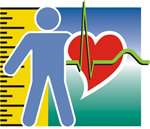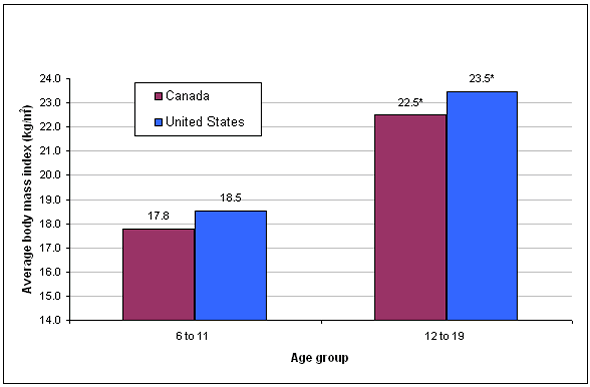Body mass index (BMI) for children and youth 2007 to 2009
Archived Content
Information identified as archived is provided for reference, research or recordkeeping purposes. It is not subject to the Government of Canada Web Standards and has not been altered or updated since it was archived. Please "contact us" to request a format other than those available.

Most Canadian children and youth recorded a healthy weight for their height when measured. Among girls, 76% measured a body mass index (BMI) that was neither overweight nor obese as did 73% of boys. No significant difference among BMI measures exists between younger and older children, or between the sexes.
About 17% of children and youth aged 6 and older have a BMI that falls into the overweight category and 9% are obese.
Comparison of Canadian and American children
The average BMI of younger Canadian children aged 6 to 11 is slightly lower than the average BMI of American children in the same age group. Canadian children in this age group had an average BMI of 17.8 kg/m2 compared with American children at 18.5 kg/m2.
There is no significant difference between the average BMI among Canadian youth aged 12 to 19 at 22.5 kg/m2 and the average BMI of American youth at 23.5 kg/m2.
Chart 1
Comparison of average BMI among Canadian and American children and youth

* The difference between the Canadian and American estimate is not statistically significant.
Sources: Canadian Health Measures Survey, 2007 to 2009. National Health and Nutrition Examination Survey, 2007-2008.
What is the BMI?
The body mass index (BMI) is a ratio calculated using a person's weight in kilograms and height in meters squared (kg/m2). It measures excess weight and not excess body fat.
Two classifications are used to interpret the BMI for children and youth. The first method adopted by the International Obesity Task Force, working with partners in the Global Prevention Alliance with a special focus on preventing childhood obesity, uses the same BMI cut-offs for children and youth as is used for adults in three categories:
| Neither overweight nor obese | BMI < 25 |
| Overweight | BMI ≥ 25 to < 30 |
| Obese | BMI ≥ 30 |
The second BMI classification developed by the Centers for Disease Control and Prevention (CDC) in the United States defines BMI ranges for children and youth to take into account normal differences in body fat between males and females and differences in body fat at various ages as children grow. In other words, the quantity of fat varies depending on age and sex, and interpretation of the BMI uses the following four categories:
| Underweight | Less than 5th percentile |
| Healthy weight | 5th percentile to less than 85th percentile |
| Overweight | 85th percentile to less than 95th percentile |
| Obese | Equal to or greater than 95th percentile |
Using this CDC method, the Canadian Health Measures Survey (CHMS) found that the majority (just under 70%) of Canadian children and youth have a BMI that shows they are a healthy weight for their height. About 4% are underweight and 26% fall into the overweight/obese categories.
Determining the body composition of children and teens
It is important to remember that although BMI correlates with the amount of body fat, BMI does not directly measure body fat.
Other methods of estimating body fat and body fat distribution to determine the overall body composition of children and teens were included in the CHMS, such as measurements of height, weight, waist circumference, hip circumference and five skinfolds.
- Date modified:
